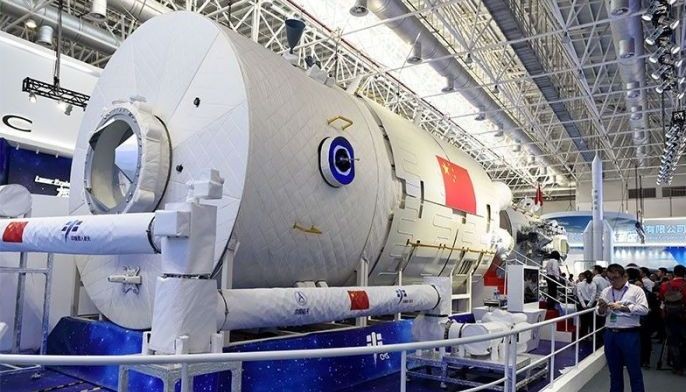NASA chief warns US Congress about Chinese space station

WASHINGTON, United States — NASA chief Jim Bridenstine told lawmakers Wednesday it was crucial for the US to maintain a presence in Earth's orbit after the International Space Station is decommissioned so that China does not gain a strategic advantage.
The first parts of the ISS were launched in 1998 and it has been continuously lived in since 2000.
The station, which serves as a space science lab and is a partnership between the US, Russia, Japan, Europe and Canada, is currently expected to be operated until 2030.
"I'll tell you one thing that has me very concerned — and that is that a day is coming when the International Space Station comes to the end of its useful life," said Bridenstine.
"In order to be able to have the United States of America have a presence in low Earth orbit, we have to be prepared for what comes next," he added.
To that end, NASA has requested $150 million for the 2021 fiscal year to help develop the commercialization of low Earth orbit, defined as 2,000 km (1,200 miles) or less from the planet's surface.
"We want to see a public-private partnership where NASA can deal with commercial space station providers, so that we can keep a permanent uninterrupted human presence in low Earth orbit," said Bridenstine.
"I don't think it's in the interest of the nation to build another International Space Station — I do think it's in the interest of the nation to support commercial industry, where NASA is a customer."
Bridenstine warned the lawmakers this was critical to maintain US space supremacy in the face of a planned Chinese space station that Beijing hopes will be operational by 2022.
The station is named Tiangong, meaning Heavenly Palace, and in June Chinese state media announced it was partnering with 23 entities from 17 countries to carry out scientific experiments on board.
These countries included both developed and developing countries, such as France, Germany and Japan, as well as Kenya and Peru, according to Xinhua news agency.
"China is rapidly building what they call the 'Chinese International Space Station,' and they're rapidly marketing that space station to all of our international partners," said Bridenstine.
"It would be a tragedy, if, after all of his time, and all of this effort, we were to abandon low Earth orbit and cede that territory."
He explained that the microgravity of ISS offered great potential for scientific advances, from innovations in pharmaceuticals to printing 3D human organs to the creation of artificial retinas to treat people with macular degeneration.
Bridenstine said that it was therefore necessary to fund NASA to pay companies to set up a space station, where it would be one of several customers in order to drive down its own costs.
This, he added, was vital to "ultimately not cede that territory to another country that doesn't have our interests at heart."
Monitor major developments on space explorations and the status of missions.
NASA reveals a sample collected from the 4.5-billion-year-old asteroid Bennu contains abundant water and carbon, offering more evidence for the theory that life on Earth was seeded from outer space.
The discovery follows a seven-year-round-trip to the distant rock as part of the OSIRIS-REx mission, which dropped off its precious payload in the Utah desert last month for painstaking scientific analysis.
"This is the biggest carbon-rich asteroid sample ever returned to Earth," NASA administrator Bill Nelson says at a press event at the Johnson Space Center in Houston, where the first images of black dust and pebbles were revealed. — AFP
NASA is set to reveal on Wednesday the first images of the largest asteroid sample ever collected in space, something scientists hope will yield clues about the earliest days of our solar system and perhaps the origins of life itself.
The OSIRIS-REx mission collected rock and dust from the asteroid Bennu in 2020, and a capsule containing the precious cargo successfully returned to Earth a little over two weeks ago, landing in the Utah desert.
It is now being painstakingly analyzed in a specialized clean room at NASA's Johnson Space Center in Houston. — AFP
A Spanish company launches the country's first private rocket on Saturday in a step towards bringing Spain into the exclusive club of space-faring nations.
The launch of the small MIURA1 rocket took place at 02:19 am (0019 GMT) from a military base in the southern region of Andalusia, according to the company, PLD Space.
The company hailed the launch as "successful" and said it had achieved all its "technical objectives". — AFP
India's Sun-monitoring spacecraft has crossed a landmark point on its journey to escape "the sphere of Earth's influence", its space agency says, days after the disappointment of its Moon rover failing to awaken.
The Aditya-L1 mission, which started its four-month journey towards the centre of the solar system on September 2, carries instruments to observe the Sun's outermost layers.
"The spacecraft has escaped the sphere of Earth's influence," the Indian Space Research Organisation (ISRO) says in a statement. — AFP
Carbon dioxide detected on Jupiter's moon Europa comes from the vast ocean beneath its icy shell, research using James Webb Space Telescope data, potentially bolstering hopes the hidden water could harbour life.
Scientists are confident there is a huge ocean of saltwater kilometres below Europa's ice-covered surface, making the moon a prime candidate for hosting extra-terrestrial life in our Solar System.
But determining whether this concealed ocean has the right chemical elements to support life has been difficult. — AFP
- Latest
- Trending


































